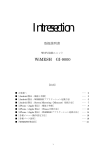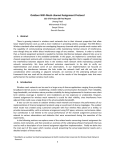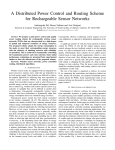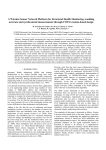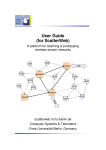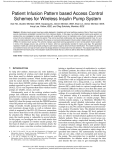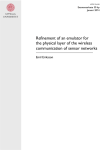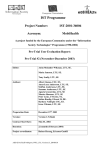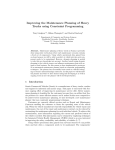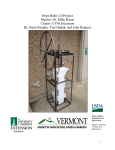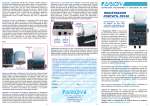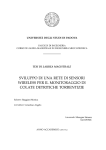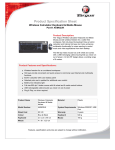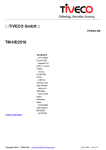Download The Impact of Temperature on Outdoor Industrial Sensornet
Transcript
1 The Impact of Temperature on Outdoor Industrial Sensornet Applications Carlo Alberto Boano†¶ , Nicolas Tsiftes† , Thiemo Voigt† , James Brown†† , and Utz Roedig†† † Swedish Institute of Computer Science, Kista, Sweden. †† Lancaster University Computing Department, Lancaster, UK. ¶ Institut für Technische Informatik, Universität zu Lübeck, Lübeck, Germany. Abstract—Wireless sensor networks are being considered for use in industrial process and control environments. Unlike traditional deployment scenarios for sensor networks, in which energy preservation is the main design principle, industrial environments stress worker safety and uninterrupted production. To fulfill these requirements, sensor networks must be able to provide performance guarantees for radio communication. In this article, we consider as a case study the deployment of a sensornet in an oil refinery in Portugal, where sensor nodes are deployed outdoors and might experience high temperature fluctuations. We investigate how the variations of ambient temperature influence data delivery performance and link quality in low-power radio communications. We also study the impact that specific implementation requirements, such as the ATEX firesafety regulations, can have on the design of the overall network. Our experiments show that temperature directly affects the communication between sensor nodes, and that significantly less transmission power is required at low temperatures. We further illustrate that it is possible to save up to 16% energy during nights and cold periods of the year, while still ensuring reliable communication among sensor nodes. In view of these experimental results, we elaborate on how the temperature influences both the design and the deployment of wireless sensor networks in industrial environments. I. I NTRODUCTION Wireless sensor networks are successfully used for applications such as precision agriculture, military surveillance, and environmental monitoring. Recently, sensornets have been considered for use in industrial control and process automation applications because of the benefits obtained from wireless deployment: reduced costs and increased system flexibility. To support this application domain, sensor networks must assure a certain data transport delay bound and a certain degree of reliability. Unfortunately, most sensor network protocols are designed to preserve energy rather than to meet performance guarantees. Hence, it is necessary to develop new protocols and mechanisms for sensornets that are able to give performance assurances while remaining reasonably energy efficient. A sensor network used for process automation and control must be able to deal with fluctuating channels and environmental characteristics. For example, a communication protocol should be able to maintain a requested packet delivery rate also when link reliability drops for a while. When sensor nodes are deployed outdoors, the fluctuations might be high because of changes in weather conditions or in the environment. To be able to design and build protocols that can compensate This is the author’s version of the work, and it is not meant for redistribution. The definitive version was published in: IEEE Transactions on Industrial Informatics (TII), Volume 6, Number 3, pag. 451-459. August 2010. Copyright 2010 IEEE 10.1109/TII.2009.2035111. and deal with varying conditions, the dynamics of channel fluctuations must be characterized. In this article, we investigate how ambient temperature and weather conditions affect link quality and data delivery in low-power wireless communication. We focus our study on a sensor network deployment in an oil refinery in Portugal. In this context nodes have to be deployed outdoors and must be encased in ATEX-compliant boxes [1] to meet EU fire safety regulations. We investigate the impact that temperature variations and ATEX casing have on the design of sensor networks. Furthermore, we characterize how the energy consumption of sensor nodes is affected by temperature. Our contributions are threefold. First, we provide experimental results that show how temperature fluctuations can create a significant variation of signal strength of up to 10 dBm. We describe how this may affect the design of applications and communication protocols that must operate outdoors. Second, we show the impact that the introduction of the ATEX casing has on low-power communication. Third, we show that temperature indirectly affects the overall energy consumption of sensor nodes. We also show that it is possible to decrease the transmission power when operating at low temperatures. Thus, nodes can save up to 16% of the power spent for transmitting packets and consequently system lifetime can be improved. In order to evaluate precisely the amount of energy saved, we measured the current consumption of all 32 available output power settings of the widely used CC2420 radio chip. We show that the measured current consumption differs from values commonly used in existing literature. This article proceeds as follows: Section II provides a description of the application context of our case study. We quantify the impact of temperature on link quality in Section III. Thereafter, we analyze the impact of ATEX-compliant casing on temperature and link quality in Section IV. In Section V we show how the temperature influences the transmission power needed to maintain network connectivity. In Section VI we discuss how the dependency between temperature and link quality affects the network design in our investigated application scenario. After an overview of the related work in Section VII, we conclude the article in Section VIII. II. A PPLICATION C ONTEXT Process automation and control applications have stringent requirements on data transport delay and reliability. In order to understand how such systems operate and the requirements they must meet, we carried out a case study in the context of the GINSENG [2] project. We investigate a wireless sensor 2 Fig. 2. A Sentilla Tmote Sky node inside an ATEX-compliant enclosure. prevent an accident. Sensors and actuators in this system are part of a closed loop system without user intervention. The information flowing in these systems is vital, and thus requires the highest level of reliability and the lowest delay bounds. Fig. 1. The GALP oil refinery in Sines, Portugal [3] is a complex industrial facility with more than 35,000 sensors and actuators installed. network deployed for process control and automation in the petrochemical industry. The GALP [3] oil refinery at Sines, Portugal (see Figure 1) is a complex industrial facility that includes a wide range of processes that must be carefully monitored and controlled. Health and safety are of utmost importance in this environment: fire prevention, safe operation of machinery, and careful handling of products have to be considered when designing a sensornet for such an environment. A. The Refinery Monitoring and Control System There are currently 35,000 sensors and actuators in use in the refinery to perform real-time monitoring of industrial operations such as leakage detection, measurement of pressure in the pipes, and control of fluid levels. The extensive monitoring of the refinery provides essential information to ensure a good health of its production processes. In the oil refinery there are 3 systems for monitoring and control the plant: the indicatory system, the control system, and the emergency system. The indicatory system is used to provide the control center with information about status and faults of the equipment, as well as general aspects of the environment. Within this system, information flows one way from the in-field sensors to the control center. Here, the sensor data is typically not vital, but should reach the control center to inform the operators of potential dangers. The control system is used to control different aspects of the refinery. Information flows in both directions: from in-field sensors to the control center, and from the control center to actuators. In this system it is important that data arrives at its intended destination quickly and reliably. Operators require instant feedback from the sensors because the actuators are used to control equipment. The emergency system is used to monitor and control mission critical systems, and to trigger alarms in order to B. Challenges of a Wireless Monitoring and Control System Most sensors and actuators in the oil refinery use wired technologies such as 4-20 mA systems. In such industrial environments, the work required to deploy new sensors can be very expensive. Because of their flexibility, wireless sensor networks can be employed to ease and reduce the cost of deployment. At the same time, they must assure the same performance as their wired counterparts do. When deploying sensors in any industrial setting it is important to consider the environment in which they will be deployed. In the context of the refinery, the sensors will be deployed mostly outdoors and they must meet a number of industrial regulations. Because nodes are deployed outdoors they are exposed to changing weather conditions and, consequently, changing link quality. Temperature changes may affect the link quality as well, so it is important to quantify these effects before designing a sensor network. The oil refinery deployment further restricts the network design because of its potentially explosive atmosphere. The European Union regulates the equipment used in such contexts as specified in the ATEX directives [1], ensuring that the equipment is not a potential source of ignition. Although it is possible to obtain ATEX certification for a sensor node, the procedure is expensive and time consuming, and needs to be repeated after any modification of the node. An alternative is to obtain the ATEX certification for a case that will contain the node, as shown in Figure 2. Such enclosures are available from many vendors and can be purchased for about 10 Euros. This is the industry’s preferred way of obtaining ATEX compliance because it is cheaper and more flexible. Obviously there is a risk that the ATEX enclosure affects the communication links since the sensor node’s antenna is inside the enclosure. Furthermore, the casing can shield the sensor node from the sun and weather conditions, as well as keeping the internal temperature higher than the external one. Since the control and emergency systems require that data is transported timely and reliably, it is necessary that the communication protocols are capable of achieving the required communication performance even if the quality of the wireless channel is fluctuating. To enable an efficient design of such protocols, we study the range and the variance of these fluctuations with respect to the changes in ambient temperature and the use of ATEX casing. 3 Signal Strength (RSSI) [dBm] The outdoor deployment in the refinery is affected by frequent temperature changes and different weather conditions. Hardware components for outdoor deployments are usually designed for an operating temperature range from −40 ◦ C to +85 ◦ C. Temperature changes, however, cause a shift of the crystal frequency, increased thermal noise of the transceiver, and saturated amplifiers [4], resulting in degraded radio performance [5], [6]. 107 RSSI LQI −80 106.5 −82 106 −84 105.5 −86 105 −88 −90 Link Quality (LQI) [CCI] −78 III. I MPACT OF T EMPERATURE ON C OMMUNICATION 104.5 0 10 20 30 40 50 Temperature [°C] A. Sentilla Tmote Sky Platform Fig. 3. Temperature impact on the RSSI and LQI indicators of the CC2420 radio chip when both sender and receiver nodes are affected by the thermal variation. Data is measured using the Sentilla Tmote Sky platform. −96 RSSI floor readings [dBm] To quantify the impact of temperature on a communication link, several experiments involving a couple of Tmote Sky nodes were carried out. The Sentilla Tmote Sky [7] uses the Chipcon 2420 radio chip [8] which operates at 2.4 GHz. The nodes run the Contiki operating system [9] with a customized application for the experiment. One node is used as a transmitter and the other node is a receiver. 256 packets, each with a 12-byte payload, are transmitted every 4 seconds. Nodes are placed at 3 meters distance, and their transmission power is kept at -3 dBm throughout the experiment. We use different 802.15.4 channels to make sure that specific interference on a channel is not biasing the data. The receiver logs the averages of the Received Signal Strength Indicator (RSSI), the Link Quality Indicator (LQI), the local temperature, and the sender’s temperature which is contained in the received packets. The receiver also records the RSSI noise floor immediately after receiving each packet. Different runs are carried out under different conditions: first both the sending node and the receiving node are exposed to an increase of temperature from between −15 and −3 ◦ C to 53 ◦ C in 90 minutes. The results of this experiment are shown in Figure 3. As we can see from the figure, the impact of temperature on the radio chip is considerable, and the higher the temperature is, the lower are the signal strength and the link quality. Figure 3 shows a signal strength drop of approximately 9 dBm. This is a substantial reduction, given that the typical range is between 0 and -100 dBm. Hence, high temperatures might lead to a loss of connectivity within the sensor network. Each point plotted is the result of an average operation over 256 packets. This enables us to monitor more precisely how the signal strength and link quality decrease, since the nominal RSSI and LQI are integer values. Figure 4 shows that the RSSI noise floor decreases as well with temperature. This is an important observation because this value is often used by the medium access control (MAC) layer to determine if the channel is currently busy or not, and, as Figure 4 shows, also the noise floor is temperature dependent. Under the same conditions, a second batch of experiments was carried out. Differently from the previous run, only the receiver node was exposed to a thermal variation from approximately −10 ◦ C to 55 ◦ C in 90 minutes. In this run we notice a drop of approximately 4 to 5 dBm in the RSSI when the temperature reaches the highest values. This variation is approximately 50% less than the one caused when both nodes are exposed to a thermal change. The RSSI noise floor decreases following the same pattern as in Figure 4. RSSI floor readings −97 −98 −99 −100 −10 0 10 20 30 40 50 Temperature [°C] Fig. 4. In addition to the RSSI and LQI indicators, temperature has also an impact on the RSSI Noise floor readings of the CC2420 radio chip. Data is measured experimentally using the Sentilla Tmote Sky platform when both sender and receiver nodes are affected by the thermal variation. We also carried out a third batch of runs in which only the sending node was exposed to a thermal change. Also under these conditions, we notice a drop of approximately 4 to 5 dBm in the RSSI when the temperature reaches the highest values. Unlike the other two sets of experiments, however, no significant difference was noticed on the RSSI noise floor. We can thus infer that the drop shown in Figure 3 is the sum of two equal contributions: one due to the heated receiver, and one due to the heated sender. B. Scatterweb MSB-430 Platform In a second set of experiments we used the Scatterweb Modular Sensor Board [10] (MSB430) platform. This platform uses a CC1020 [11] radio chip running at 868 MHz. The experimental setup was similar to the setup used for the previously described experiment. However, only the RSSI and RSSI noise floor were recorded since the LQI is not available in the CC1020 radio. As in the previous experiment, the impact on communication is highest when both sensor nodes are exposed to thermal change. Figure 5 shows the RSSI drop when temperature increases from −10 ◦ C to 50 ◦ C. The results show a similar dependence between temperature and RSSI as in the previous experiment: Figure 5 shows a signal strength drop of approximately 6 dBm over the investigated temperature range. Like with the Tmote Sky platform, the noise floor of the MSB430 platform also is affected by temperature, as shown in Figure 6. Temperature [°C] RSSI −60 −62 Temperature sender [°C] Temperature receiver [°C] 60 40 20 0 0 −66 −68 −10 12 18 24 0 10 20 30 40 50 RSSI −70 −75 −80 −85 0 Temperature [°C] −96 6 12 18 24 Time [minutes] Fig. 5. Temperature impact on the RSSI of the CC1020 radio chip when both sender and receiver nodes are affected by the thermal variation. The data is measured using the Scatterweb MSB430 platform with an SMA antenna. RSSI floor readings [dBm] 6 −64 RSSI [dBm] Signal Strength (RSSI) [dBm] 4 Fig. 7. Sensor nodes enclosed in an ATEX-compliant casing: a high temperature inside the case can be detrimental to low-power communication. Confirming the previous results, the RSSI decreases when the temperature increases. Temperature varies in the ATEX case of both sender and receiver. RSSI floor readings IV. T HE ATEX C ERTIFICATION R EQUIREMENT −98 In order to achieve ATEX compliance, sensor nodes can be enclosed in ATEX compliant casings. This procedure avoids costly certification procedures, especially for small modifications of the sensor node hardware. −100 −102 −104 −106 −10 0 10 20 30 40 50 Temperature [°C] Fig. 6. In addition to the RSSI, temperature has also an impact on the RSSI Noise floor readings of the CC1020 radio chip. The data is measured using the Scatterweb MSB430 platform with an SMA antenna. Both sender and receiver nodes are affected by the thermal variation. C. Discussion of the Obtained Results From our experimental results it can be concluded that the observed temperature dependency exists on different platforms and for different radio frequencies. The observations are not antenna specific as the temperature impact is visible on both the Tmote Sky which has a built-in PCB antenna, and on the MSB430 which uses an external antenna connected via SMA. The effects are caused by the radio chip. More precisely, the components affected by temperature are the power amplifier of the transmitter and the LNA (that amplifies the RF signal from the antenna) of the receiver [4], [5]. If a temperature increase affects the power amplifier of the radio chip negatively, the signal strength of transmissions will decrease with the increasing temperature if the transmission power is constant. This partially explains why in our experiments the RSSI at the receiver decreases when the sender is warmed. At the same time, this means that a sensor node running at high temperatures needs a higher transmission power to obtain the same signal strength as is possible to obtain when transmitting at lower temperatures. This implies that also the transmission power is influenced by temperature. In addition to this, the RSSI is further reduced when the receiver is exposed to high temperature, which is due to the lower LNA amplification. This impacts only the values of RSSI and RSSI noise that are returned by the chip because the environmental noise obviously does not decrease with temperature. A. ATEX Enclosures When sensor nodes are enclosed in ATEX-compliant cases, the radio propagation might be affected by the casing. We carried out several experiments to evaluate if there is a decrease of performance when sensors are enclosed into ATEX cases. However, the results did not show a negative systematic trend of the RSSI when the nodes are inside the case. This applies at different distances and locations, both indoor and outdoor. The node’s orientation, the deployment location, the presence of obstacles in the surroundings, and the environmental interference are the variables that affect the radio signal reception rather than the presence of the casing. B. ATEX Enclosures and Temperature The ATEX case does not have an impact on radio propagation and hence does not affect communication directly. However, the casing has an effect on the temperature of the sensor node and, thus, has an indirect impact on communication. A high temperature inside the ATEX case can be detrimental to low-power communication, and the temperature effect is largest when the internal temperature of both the cases of sender and receiver is high. After carrying out the same set of experiments as in Section III-A, but enclosing both the sensor nodes in ATEX casings, we detected a rise in the RSSI of approximately 9 dBm, as shown in Figure 7. The experimental results show again that temperature changes have a significant impact on communication. In order to ensure stable communication links, it might therefore be useful to avoid nodes exposed to direct sunlight. In the investigated refinery scenario this is possible since the deployment is highly controlled, and sensors are not deployed randomly. The airtight ATEX casing creates a warming effect that increases the inner temperature. In our application, the temperature inside the ATEX cases may follow dangerous patterns with respect to our discussion in Section III, and might degrade 5 Temperature [°C] 30 20 10 0 18:00 80 Temperature [°C] V. T HE I MPACT OF T EMPERATURE ON TX P OWER Outside ATEX casing Inside ATEX casing 22:00 02:00 06:00 Time of the day [hh:mm] 10:00 Outside ATEX casing Inside ATEX casing 60 40 20 0 0 20 40 60 80 Time [Minutes] Fig. 8. Temperature registered on Tmote Sky nodes placed inside and outside ATEX-compliant enclosures at different hours of the day. The top figure shows how, during the night, the casing creates a warming effect on the sensor nodes, and the temperature inside the case is higher than outside. The bottom figure shows that when the sun shines directly on the sensor motes, the case shields the nodes, and slows down the inner increase of temperature. the performance of the network or disrupt the connectivity between sensors. A high temperature–partly caused by the warming effect–can reduce the received signal strength. For this reason we inspect the behavior of the temperature inside the ATEX casing with different weather conditions at different hours of the day. We use Contiki [9] and Sentilla Tmote Sky nodes equipped with Sensirion SHT11 temperature sensors [12] to perform such outdoor experiments. We compare the behavior of nodes enclosed in ATEX-compliant cases with nodes that are not enclosed. Figure 8 shows the temperature inside and outside the case at different times of the day. During nighttime, the airtight casing keeps the nodes at a higher temperature than the ones outside the case (top figure). During daytime, instead, when the sun shines directly on the sensors, the nodes outside the ATEX-compliant cases will be influenced faster, and the temperature will rise quickly (bottom figure). In other words, the case shields the sensor nodes and slows down the increase of temperature on the board, which helps to avoid sudden temperature changes. This implies that sensor nodes may have enough time to modify the routing schemes before the temperature becomes too high. This is an important observation since the enclosure of sensor nodes in plastic cases is typically considered to bring disadvantages to the communication. In the case of the oil refinery, the indicatory system may switch the behavior from real-time data communication to data collection (i.e., waiting for the temperature to decrease again before transmitting). This will avoid retransmissions and a consequent waste of energy, and can be done since the data of the indicatory system is not time critical. The deployments for the control and emergency systems should instead be carried out so that even the highest temperature combined with the warming effect does not increase the latency of the real-time communication. Sections III and IV describe the influence of temperature and ATEX enclosures on transmission links in industrial outdoor deployments. The experimental results show that an increase in temperature leads to a reduction of the signal strength at the receiving side, due to the impact of temperature on the radio driver, and more precisely on the power amplifier of the transmitter [4], [5]. The impact of temperature on the power amplifier directly affects the strength of the outgoing radio signal: at higher temperatures the signal gets weaker. Therefore it can be expected that with an increase in temperature, a higher transmission power is required to maintain the same signal strength and thus to ensure successful data transmission. We carried out several long-term outdoor experiments to investigate this effect. The aim was to determine the minimum transmission power level necessary to ensure successful data transmission between two Tmote Sky nodes. Given a pool of N packets, we define the minimum power to reliably communicate as the minimum power necessary to achieve 100% delivery, i.e. we expect exactly N received packets. Furthermore, we define the minimum power to barely communicate as the minimum power necessary to receive at least one packet, without caring about the actual delivery rate. A. Experimental setup We divide the deployed nodes in pairs consisting of a sending and a receiving node running the Contiki operating system [9]. The sender transmits a train of 15 packets with 12-byte payloads, starting with the highest transmission power available. Each packet contains a sequence number and the information about the transmission power used by the sender. The receiving node uses the same transmission power as advertised in the message to reply to the sender. The receiver sends an acknowledgment for every received packet, identified by its sequence number. If the sender receives at least one acknowledgment for the 15 packets sent, it will decrease the transmission power by one unit. We did not use a MAC protocol to organize channel access as we wanted to analyze only channel characteristics. We use static Tmote Sky nodes to run this experiment during different days and nights. B. Transmission power levels in the CC2420 radio The transmission power in the CC2420 radio driver can be set into 32 different values, ranging from roughly -55 dBm to 0 dBm through the PA POWER register. Unfortunately, the CC2420 datasheet [4] documents only 8 discrete levels ranging from -25 dBm to 0 dBm, and the radio manufacturer confirms that the relationship between the register setting and the output power is not linear [13]. However, in order to compute the unknown values, estimations have been used, such as the cubic spline interpolation [14]. We measured the current consumption for all PA POWER values experimentally using an oscilloscope. This is an important contribution of this paper, as information about the transmission power of the CC2420 does not exist [13], [14]. We measure the current consumption 24 Current consumption 20 Current [mA] 16 Current [mA] Experimental (Oscilloscope) Theoretical (CC2420 manual) 12 8 4 16 12 8 4 0 Temperature [°C] 20 80 TX power 6 30 40 20 0 0 INIT 0 5 10 15 20 25 30 Transmission power [PA_POWER] 0 5 10 15 20 25 30 Transmission power [PA_POWER] Fig. 9. Current consumption in the CC2420 radio chip. The left figure shows the current measured with the oscilloscope while increasing the PA POWER level from 0 to 31. The first spike occurs because the radio is switched on and needs to be initialized (INIT). The right figure shows a comparison between the values provided by the CC2420 manual and the experimental results. Sender Receiver 60 Min TX power to barely communicate 20 10 0 29/08 03:00 29/08 19:00 30/08 11:00 31/08 03:00 Temperature [°C] 80 TX power Time of the day [day/month hh:mm] 30 Sender Receiver 60 40 20 0 Min TX power to barely communicate Min TX power to reliably communicate 20 10 0 17/08 21:00 18/08 05:00 18/08 13:00 18/08 21:00 Time of the day [day/month hh:mm] Fig. 10. Minimum transmission power required to communicate by two sensor nodes. During daytime the sun shines directly on the motes, and increases significantly the temperature on the board. With respect to nighttime operations, the sensor nodes require roughly 16% more energy for a successful transmission during the hottest time of the day. In this example, sensor nodes were deployed at a distance of around 7 meters and were exposed to sunlight from 8:00 to 11:00. of the different PA POWER levels using a Velleman PCSU 1000 oscilloscope [15] over a resistance of 100Ω. Figure 9 shows the characteristic of the current consumption of the Chipcon CC2420 radio that we measured experimentally. We confirm that the slope is not linear, which shows the importance of measuring the value for each power level. These values are used to calculate the current consumption for the PA POWER values not specified in the CC2420 manual. C. Experimental results Our experimental results show that the minimum transmission power to communicate is considerably affected by temperature variations. This applies for temperature fluctuations between day and night and for changing weather conditions as well. All the results we obtained in our runs show a significant increase in the minimum transmission power, indicating that reducing the transmission power during the coldest time of the day or the year may help in saving energy. Figure 10 shows a daily deployment in Germany during the summer, and we can see that when the sun shines on the sensor nodes, the temperature reaches up to 70 ◦ C, thus 55 ◦ C higher than during the night. Nodes are not exposed to wind, and they are placed approximately 7 meters away from each other. The high thermal variation causes an increase of the minimum Fig. 11. Minimum transmission power required to communicate between two sensor nodes over multiple days. During daytime the sun shines directly on the sending node, and significantly increases the temperature on its board. With respect to nighttime operations, the sending node requires roughly 10% more energy for a successful transmission during the hottest time of the day. In this example, sensor nodes were at a distance of around 13 meters and– unlike in the previous experiment–only the sender was exposed to sunlight during the afternoon. transmission power to barely communicate from PA POWER 11 to 17. At the same way, the minimum transmission power to reliably communicate increases from PA POWER 13 to 22. According to our experimental results shown in Figure 9, the current consumption increases by 11.4% in the first case, and by 16.3% if we want to achieve a 100% delivery rate. During this experiment, both sender and receiver nodes are affected by high temperature changes. This implies that in addition to the sender transmissions, also the acknowledgments sent from the receiver need a higher transmission power to reach their destination. Figure 11 shows a deployment in Sweden during the end of August. The results are relative to a sunny weekend, where only the sending node is exposed to the sunlight. We can see that when the sun shines directly on the mote, the temperature increases up to 48 ◦ C, thus 25 ◦ C higher than during the night. Nodes are not exposed to wind, and they are approximately 13 meters far away from each other. The nodes are placed in such a position that they cannot achieve 100% delivery even with the highest transmission power available. However, we notice how the minimum transmission power to barely communicate increases from PA POWER 20 to 28 when the temperature increases. According to our experimental results shown in Figure 9, the current consumption needed to barely communicate increases with 10.1%. This result confirms that even when the temperature variation is not as high as it was in the deployment in Germany, the impact of temperature is still considerable. Another experiment was carried out in Sweden during the spring using different distances between the two Sky nodes (the distance was gradually increased from 50 cm to 20 m). The minimum transmission power was then compared when temperature in both nodes was 18 ◦ C and 38 ◦ C respectively. Figure 12 shows the results of the experiments, where PA POWER represents the transmission power level used in the CC2420 radio. The plot shows the minimum transmission power to barely communicate, and confirms that Transmission power [PA_POWER] 7 25 18 Celsius degrees 38 Celsius degrees 20 15 10 5 0 50 cm 2 m 5m 10 m 15 m 20 m Distance between motes Fig. 12. Minimum transmission power required for a successful communication between two sensor nodes at different distances. Regardless of the distance between the motes, an higher temperature requires an higher transmission power to maintain a stable communication between nodes. the temperature impact applies at all distances. We further checked whether the nightly operations were requiring less energy because of the reduction in temperature or because of the minor environmental noise. During night there is not only a decrease in temperature but also a reduction of ambient noise because generally fewer electric devices are operating. We carried out many different experiments, and the ones shown in Figure 10 and 11 were explicitly chosen since they do not suffer from external interference. In the first plot, the sun is shining on the two motes only from 8:00 to 11:00, while the motes were in the shadow during the midday and the afternoon. We can clearly see that both temperature and transmission power decrease after 11:00, showing that the correlation is with the temperature rather than with the environmental noise. The second experiment is carried out in an office during weekends, so to avoid external interference. In summary, our experimental results show that reducing the transmission power during nighttime and the coldest time of the year is a good practice that can save up to 16% of the energy consumption. Creating a control loop algorithm that adapts the transmission power to the temperature sensed by the sensor nodes may thus help to increase the overall network lifetime. Beside the temperature impact, it is also good to keep the transmission power as low as possible, because increasing the transmission power may result in more contention, although the link quality improves [16]. VI. I MPACT ON A PPLICATION S CENARIO The influence of temperature variations on communication link quality must be taken into account when deploying a wireless sensor network in the application context outlined in Section II. In particular, the following aspects should be considered when designing and deploying a sensornet for the oil refinery context: Deployment Time: The time chosen to deploy and test the equipment in the refinery is crucial. New devices within the refinery are typically deployed and tested during the evening or night when the refinery is at its quietest. In the south of Portugal, temperatures can vary in the summer between 35 ◦ C during the day and 20 ◦ C during night times. In addition, some of the nodes may be exposed to direct sunlight which will increase the temperature even further (see Figure 10). Thus, temperature variations between 18 ◦ C and 38 ◦ C as used to derive results shown in Figure 12 have to be expected. The graph shows that two devices can communicate over a greater distance when the environmental temperature is lower than at times of higher temperature. For example, a communication link configured with a transmission power level 3 to span a 5 meters distance at night will only be able to cover a distance of 2 meters during the day, which might result in a disconnected network. Hence, devices deployed and tested during the usual refinery maintenance period (which coincides with the coldest time) may not be able to communicate during daytime, when temperatures are higher. Therefore it is important that the communications are tested during the hottest times of the year. Maintenance: Wireless sensor nodes within the refinery will be battery powered and therefore only have a finite lifetime. Continued operations can only be ensured when batteries are replaced before depletion. The cost of replacing batteries of 35,000 nodes within the refinery is very high and cannot be neglected. Maintenance personnel must be employed to ensure that batteries are replaced at the right time, which accounts for the largest part of the maintenance cost, while actual material cost for batteries is insignificant in comparison. Hence, it is important to achieve a long node lifetime to reduce the maintenance frequency. It is not advisable to use the maximum transmission power that a node provides. To conserve energy, the power should be set to the minimum required to bridge the required distance. Given the results shown in Figures 10, 11, and 12 the temperature dependency of the transmission power should be taken into account as well. Saving energy during nighttime and during the coldest seasons prolongs the battery duration, and therefore it is worth considering to adapt the transmission power to the ambient temperature. Protocol Design: As pointed out in the previous paragraph it is necessary to take temperature into account also when deciding which transmission power should be used. Ideally, a node should adapt automatically to the proper transmission power setting. Generally, it is difficult to construct a stable adaptive algorithm if the temperature is fluctuating heavily over a short time span. However, as shown in Figure 8, the ATEX casing shields the sensor node from erratic temperature changes. Hence, we believe it is possible to devise a stable and efficient algorithm for transmission power adaptation, such as the one shown by Hackmann et al. [16]. VII. R ELATED W ORK Several researchers have shown that outdoor sensor networks are affected by weather conditions and temperature. Thelen et al. [17] described how radio waves propagate better under weather conditions with high humidity in their potato field deployment. The results of Anastasi et al. [18], Sun et al. [19], and Capsuto et al. [20] suggest that weather effects, specifically fog and rain, may have a severe impact on the transmission range of sensor nodes, in particular with respect to the packet reception rate. Boano et al. [6] quantified the impact on rain and fog with respect to the signal strength and the link quality under different platforms, showing that 8 rainfall of less than 2-3 mm/hour has a negligible effect on the signal strength. When the rainfall is heavier, however, the connectivity might be disrupted. Bannister et al. have shown that high temperatures negatively affect communication between sensor nodes [5]. In their deployment in the Sonoran Desert of the southwestern United States, the reduction of the signal strength was largest during the hottest time of the day. We quantify the impact of temperature also at lower temperatures, using different platforms and radio frequencies. We show that also the LQI, in addition to the RSSI, is affected. This is very important, since RSSI and LQI are used often to estimate the future packet reception rate of communication links [21], [22]. Unlike previous work, we show the influence that temperature has on the minimum transmission power necessary for communication between sensor nodes. We show that sensor networks operating at low temperatures can decrease their transmission power and save up to 16% energy, and thus increase their lifetime. To the best of our knowledge, this is a novel contribution. There are different protocols implemented to adapt the transmission power such as ATPC [23], but they adapt the transmission power based on neighbor status. In order to obtain a high precision in our results, we measured the current consumption of all the 32 output power levels in the CC2420 radio chip. Our experimental results fill up the knowledge gap in the information provided by the manual [8] that is limiting researchers’ work, as highlighted by Hauer et al. [13]. In this way, we evaluate the precise amount of energy saved, without resorting to empirical or statistical approaches as others have done [14] or using only the transmission channels for which the power consumption is provided by the manual as done by Hackman et al. [16]. We show how obtained transmission power is non-linear in relation to the configured power level (PA POWER), and that a regression may not be the appropriate choice. Most sensornets for industrial control and automation applications must comply with the ATEX directive 94/9/EC [1] for equipment and protective systems intended for use in potentially explosive atmospheres. To the best of our knowledge, there are no studies that assess if compliance with this standard has an impact on wireless sensor networks performance. Our measurements aim to close this knowledge gap. VIII. C ONCLUSIONS In this article we investigated the temperature influence on low-power communications. For our case study, we used the deployment of an outdoor wireless sensor network in an oil refinery in which ATEX compliance is a necessity. Our experimental results show that temperature has a major effect on signal strength and link quality, and that operations at lower temperatures might require up to 16% less power to maintain a reliable communication. We have further explained how this affects the deployment and the design of the network in the refinery. We believe that the findings presented in this article can help to improve the design of wireless sensor network deployments for industrial process and control applications. Furthermore, the presented results can be used to construct energy-efficient protocols that adapt the transmission power to the measured ambient temperature in order to save energy and increase the lifetime of the system. ACKNOWLEDGMENTS This work has been partially supported by the European Commission under FP7 with contracts FP7-ICT-224282 (GINSENG) and FP7-2007-2-224053 (CONET, the Cooperating Objects Network of Excellence). This work has been partially financed by SSF and VINNOVA, the Swedish Agency for Innovation Systems. This work has been also partially financed by the Cluster of Excellence 306/1 ”Inflammation at Interfaces” (Excellence Initiative, Germany, since 2006). R EFERENCES [1] “ATEX Guidelines on the Appl. of Dir. 94/9/EC: Equipment intended for use in Potentially Expl. Atmospheres. 3rd edition.” Jun. 2009. [2] “The GINSENG project: Performance control in industrial wireless sensor networks.” [Online]. Available: http://www.ict-ginseng.eu/ [3] “GALP energy,” Web page. [Online]. Available: http://www.galp.pt/ [4] CC2400 datasheet - 2.4 GHz Low-Power RF Transceiver (Rev. 1.5), Chipcon AS, Mar. 2006. [5] K. Bannister, G. Giorgetti, and S. Gupta, “Wireless sensor networking for hot applications: Effects of temperature on signal strength, data collection and localization,” in Proc. of the 5th Workshop on Emb. Networked Sensors (HotEmNets), Charlottesville, Virginia, Jun. 2008. [6] C. A. Boano, J. Brown, Z. He, U. Roedig, and T. Voigt, “Low-Power Radio Communication in Industrial Outdoor Deployments: The Impact of Weather Conditions and ATEX-compliance,” in Proceedings of the 1st Int. Conference on Sensor Networks Applications, Experimentation and Logistics (Sensappeal), Athens, Greece, Sep. 2009. [7] Tmote Sky datasheet, Edition 1.04 ed., Moteiv Corporation, Nov. 2006. [8] CC2420 datasheet - 2.4 GHz IEEE 802.15.4 / ZigBee-Ready RF Transceiver (Rev. B), Chipcon AS, Mar. 2007. [9] A. Dunkels, B. Grönvall, and T. Voigt, “Contiki: a lightweight and flexible operating system for tiny networked sensors,” in Proc. of the Workshop on Emb. Networked Sensors, Tampa, Florida, Nov. 2004. [10] MSB: Modular Sensor Board datasheet, ScatterWeb GmbH, Nov. 2007. [11] CC1020 datasheet - Low-Power RF Transceiver for Narrowband Systems (Rev. B), Chipcon AS, Jul. 2008. [12] SHT1x Humidity and Temperature Sensor datasheet, Version 2.04 ed., Sensirion AG, May 2005. [13] J.-H. Hauer, V. Handziski, and A. Wolisz, “Experimental Study of the Impact of WLAN Interference on IEEE 802.15.4 BAN,” in Proc. of 6th European Conf. on Wireless Sensor Networks, Cork, Ireland, Feb. 2009. [14] R. de Paz Alberola and D. Pesch, “AvroraZ: Extending Avrora with an IEEE 802.15.4 Compliant Radio Chip Model,” in Proc. of the 3rd ’PM2HW2N’ Workshop, Vancouver, Canada, Oct. 2008. [15] Velleman, “Digital Storage Oscill. User Manual PCSU 1000,” 2005. [16] G. Hackmann, O. Chipara, and C. Lu, “Robust Topology Control for Indoor WSN,” in Proc. of the 6th Conf. on Networked Emb. Sensor Systems (SenSys), Raleigh, North Carolina, USA, Nov. 2008. [17] J. Thelen, D. Goense, and K. Langendoen, “Radio wave propagation in potato fields,” in Proceedings of the 1st workshop on wireless network measurement (WiNMee’05), Riva del Garda, Italy, Apr. 2005. [18] G. Anastasi, A. Falchi, A. Passarella, M. Conti, and E. Gregori, “Performance measurements of motes sensor networks,” in Proc. of the 7th MSWiM symposium, Venice, Italy, Oct. 2004. [19] J. Sun and R. C. Oliver, “An experimental evaluation of temporal characteristics of communication links in outdoor sensor networks,” in Proc. of REALWSN’06, Uppsala, Sweden, Jun. 2006. [20] B. Capsuto and J. Frolik, “A system to monitor signal fade due to weather phenomena for outdoor sensor systems,” in Proc. of the 5th IPSN, Demo session, Nashville, TN, USA, Apr. 2006. [21] K. Srinivasan and P. Levis, “RSSI is Under Appreciated,” in Proc. of the 3rd ’EmNetS’ Workshop, Cambridge, MA, USA, May 2006. [22] M. Holland, R. Aures, and W. Heinzelman, “Experimental investigation of radio performance in WSN,” in Proc. of the Workshop on Wireless Mesh Networks (WiMesh), Reston, Virginia, Sep. 2006. [23] S. Lin, J. Zhang, G. Zhou, L. Gu, T. He, and J. A. Stankovic, “ATPC: Adaptive Transmission Power Control for WSN,” in Proc. of the 4th SenSys Conference, Boulder, Colorado, USA, Nov. 2006.








